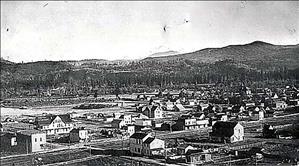On June 18, 1891, Sumas incorporates as a fourth-class town. Sumas -- pronounced Soo-mass -- is located in northwestern Whatcom County on the Canadian border, and a border crossing has just been established there. The town will boom briefly as a supply center during the Mount Baker Gold Rush in the late 1890s, and again in the 1920s when it hosts the Sumas Roundup. But for most of its history Sumas will remain a small, quiet, agricultural town, with many of its citizens enjoying both U.S. and Canadian citizenship.
A Town is Born
Sumas gets its name from the Cowichan Indians, a Canadian tribe that shared with the Nooksack Tribe the flat prairie where Sumas later developed. The name means "land without trees," and it was also given to the Sumas Prairie, the Sumas River, Sumas Lake (drained in the 1920s), and not one but two local mountains, one on the Canadian side of the border, one on the American side. The city of Sumas is located on a flood plain, and it has suffered major floods numerous times throughout its history.
Robert Johnson was the first known permanent non-Native settler in Sumas. He arrived in 1872, and a few other settlers moved into the area over the next 10 years. However, it was the 1880s before there were enough people to begin forming a real community, which was called Sumas City in its earliest years. The plat for the town of Sumas was filed on April 24, 1889, but at that time it was still largely an itinerant settlement of tents housing farmers and loggers. That changed in 1891 with the arrival of not one but three railroads in Sumas, as well as the establishment of a border crossing there that same year. The men of the community drafted an incorporation petition, obtained the requisite number of signatures to hold an election, and made sure notice of the pending vote was duly published for at least two weeks in the Sumas News.
The election was held at Van Valkenburg Hall on June 13, 1891. (A photograph of Sumas taken about that year shows the hall was one of the few buildings in town.) Incorporation was approved by a vote of 96 to 16. William Sharpe was the town's first mayor, and the first five town council members were O. H. Eyerly, John J. Fuller, R. U. Leitch, Joseph Metzger, and Charles Walsh. Jesse Hall was elected the town's first treasurer. Incorporation papers were formally filed with the secretary of state on June 18, 1891.
Early Years
The town's population surged past 2,000 in its earliest years, and surged again in the late 1890s when gold was discovered just north of nearby Mount Baker. A horde of excited prospectors descended upon the region, and by the spring of 1898 Sumas had become the supply center for eager miners. The gold rush soon fizzled, the town's population quickly plummeted, and by the 1900 U.S. Census, Sumas recorded a mere 319 residents. But it wasn't over for mining operations in the area, which continued for another half a century.
Sumas also put itself on the map in the 1920s when it hosted the Sumas Roundup, a traditional rodeo that in its heyday brought tens of thousands of Americans and Canadians to the little town to "see 'em buck" (the rodeo's motto). Cowboys -- and a few cowgirls -- competed in such events as steer wrestling, calf roping, and trick riding. The Great Depression of the 1930s caused the rodeo to be canceled for several years, but it returned in 1937 and continued through 1940.
Border Controversy
Through the rest of the twentieth century Sumas was seldom in the news other than during one of its floods or if something unusual happened at its border crossing. One such incident put Sumas in the news early in 2002, when the Washington State Supreme Court ruled in State v. Norman that the state extends north of the 49th parallel, which the state constitution defines as its northern boundary. An error when the international boundary along the 49th parallel was first surveyed near Sumas in the late 1850s had drawn the boundary on the ground about 800 feet north of the actual 49th parallel. The error, long since known, was of little concern to local residents on either the American or Canadian side of the line, some of whom referred to the area north of Garfield Street in Sumas as the "Canada strip" since it lay north of the 49th parallel (Hopper).
The mistake attracted more notice after a 1996 arrest at the U.S. border crossing in Sumas, located on U.S. territory but several hundred feet north of the 49th parallel. In consolidated cases three defendants, arrested at border crossings north of the 49th parallel and convicted in state court for possession offenses based on items discovered during those arrests, argued that their convictions were illegal since they were north of the 49th parallel, and thus not in Washington, when the alleged crimes occurred. The state supreme court rejected the argument, ruling that "this state's northern boundary is coextensive with the international boundary as marked" (State v. Norman).
Sumas's population ranged between 600 and 750 residents from 1930 to 1990, but it has grown in the early twenty-first century, doubling from 744 in 1990 to an estimated 1,464 in 2017. In 1971 the town council passed an ordinance changing Sumas's status from a town to a non-charter code city, giving it the greatest amount of local control permissible under state law.

